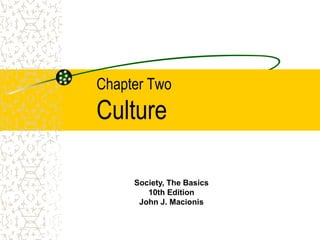
Culture
- 1. Chapter Two Culture Society, The Basics 10th Edition John J. Macionis
- 2. What is Culture? Culture – the ways of thinking, the ways of acting, and the material objects that together form a people’s way of life Only humans rely on culture rather than instinct to ensure survival.
- 3. What is Culture? Nonmaterial culture – ideas created by members of a society. Material culture – tangible things created by members of a society.
- 4. What is Culture? Society refers to people who interact in a defined territory and share culture. Culture shock refers to personal disorientation when experiencing an unfamiliar way of life.
- 5. How Many Cultures? • One indication of culture is language • Global estimates document 7,000 languages • In the USA, there are about 200 languages • Upcoming decades will show the disappearance of hundreds of languages
- 6. The Elements of Culture Although cultures vary, they all have five common components: (1) Symbols (2) Language (3) Values and Beliefs (4) Norms (5) Ideal and Real Culture
- 7. Elements of Culture Symbols Symbols – anything that carries a particular meaning recognized by people who share culture.
- 8. Elements of Culture Symbols Symbols – collective creations General Marketing • Aimed at a total population Segmented Marketing • Aimed at a specific population
- 9. Elements of Culture Language Language – a system of symbols that allows people to communicate with one another. Language allows for the continuity of culture. BBC
- 10. Elements of Culture Language Cultural transmission – the process by which one generation passes culture to the next. Every society transmits culture through speech.
- 11. The Sapir-Whorf Thesis Languages are not just different sets of labels for the same reality. All languages fuse symbols with distinctive emotions. The Sapir-Whorf Thesis – people perceive the world through the cultural lens of language.
- 12. Elements of Culture Values and Beliefs Values – culturally defined standards by which people assess desirability, goodness, and beauty and that serve as broad guidelines for social living. Values are abstract standards of goodness.
- 13. Elements of Culture Values and Beliefs Beliefs – specific statements that people hold to be true. Beliefs are particular matters that individuals consider true or false.
- 14. Elements of Culture Societies show significant cultural variations in their favorite sports. Canada: Ice Hockey Jamaica: Cricket Thailand: Kite flying China: tai chi chuan
- 15. Key Values of United States Culture Equal Opportunity Achievement and Success Material Comfort Activity and Work Practicality and Efficiency Robin M. Williams, Jr.
- 16. Key Values of United States Culture Progress Science Democracy and Free Enterprise Freedom Racism and Group Superiority Robin M. Williams, Jr.
- 17. Elements of Culture Norms o Norms – rules and expectations by which a society guides the behavior of its members. o Most important norms in a culture apply everywhere and at all times.
- 18. Elements of Culture Norms Mores – norms that are widely observed and have great moral significance. Folkways – norms for routine, casual interaction.
- 19. Elements of Culture Norms Mores Inspire intense reactions Punishment inevitably follows Societal taboos such as: Murder Treason Child sexual abuse (Right vs. wrong)
- 20. Elements of Culture Norms Folkways (polite vs. rude) – People chew quietly with mouths closed Accepting one’s place in line People avoid facing each other in elevators No written rules No one physically harmed
- 21. Technology & Culture Sociocultural evolution Material culture also reflects a society’s technology – knowledge that people use to make a way of life in their surroundings.
- 22. Technology and Culture hunting and gathering societies horticultural & pastoralism agriculture industry postindustrial information technology
- 23. Cultural Diversity Cultural diversity can involve social class. Many cultural patterns are readily accessible to only some members of a society.
- 24. Cultural Diversity Popular culture – cultural patterns that are widespread among a population. High culture – cultural patterns that distinguish a society’s elite
- 25. Subcultures Subculture – cultural patterns that set apart some segment of society’s population.
- 26. Multiculturalism Multiculturalism – an educational program recognizing the cultural diversity of the United States and promoting the equality of all cultural traditions.
- 27. Multiculturalism Eurocentrism – the dominance of European cultural patterns. Afrocentrism – the dominance of African cultural patterns.
- 28. Counterculture Examples: • Hippies of the 60’s • Street Gangs • Hare Krishna • Extreme right- wing religious groups Counterculture – cultural patterns that rejects and opposes those widely accepted within a society.
- 29. Cultural Change • Cultural integration – the close relationships among various elements of a cultural system. • Some elements of culture change faster than others – cultural lag.
- 30. Cultural Change Cultural integration • Examples: Women in the workforce •Later first marriages •Change in family patterns •Increased use of day care
- 31. Cultural Change Cultural lag • Examples: Contraception •Increased availability •Use by adolescents Medical Advances •Little or no ability to provide higher quality of life
- 32. Cultural Change Cultural changes • New cultural elements – Cell phones – Blackberry – iPhones • Diffusion – Spread of objects from one society to another
- 33. Ethnocentrism and Cultural Relativism Ethnocentrism – the practice of judging another culture by the standards of one’s own culture.
- 34. Ethnocentrism and Cultural Relativism Cultural Relativism – the practice of evaluating a culture by that culture’s own standards. Cultural Universals
- 35. A Global Culture Global economy: the flow of goods Global communication: the flow of information Global migration: the flow of people
- 36. Theoretical Analysis of Culture The structural–functional paradigm depicts culture as a complex strategy for meeting human needs. The social–conflict paradigm suggests that many cultural traits function to the advantage of some and the disadvantage of others. Sociobiology explores ways in which human biology affects how we create culture.
